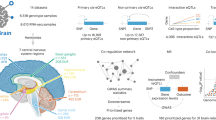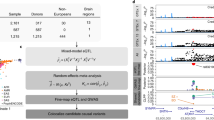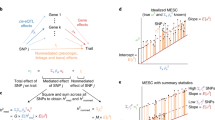Abstract
We introduce an approach to identify disease-relevant tissues and cell types by analyzing gene expression data together with genome-wide association study (GWAS) summary statistics. Our approach uses stratified linkage disequilibrium (LD) score regression to test whether disease heritability is enriched in regions surrounding genes with the highest specific expression in a given tissue. We applied our approach to gene expression data from several sources together with GWAS summary statistics for 48 diseases and traits (average N = 169,331) and found significant tissue-specific enrichments (false discovery rate (FDR) < 5%) for 34 traits. In our analysis of multiple tissues, we detected a broad range of enrichments that recapitulated known biology. In our brain-specific analysis, significant enrichments included an enrichment of inhibitory over excitatory neurons for bipolar disorder, and excitatory over inhibitory neurons for schizophrenia and body mass index. Our results demonstrate that our polygenic approach is a powerful way to leverage gene expression data for interpreting GWAS signals.
This is a preview of subscription content, access via your institution
Access options
Access Nature and 54 other Nature Portfolio journals
Get Nature+, our best-value online-access subscription
$29.99 / 30 days
cancel any time
Subscribe to this journal
Receive 12 print issues and online access
$209.00 per year
only $17.42 per issue
Buy this article
- Purchase on Springer Link
- Instant access to full article PDF
Prices may be subject to local taxes which are calculated during checkout





Similar content being viewed by others
References
ENCODE Project Consortium. An integrated encyclopedia of DNA elements in the human genome. Nature 489, 57–74 (2012).
Kundaje, A. et al. Integrative analysis of 111 reference human epigenomes. Nature 518, 317–330 (2015).
GTEx Consortium. The Genotype–Tissue Expression (GTEx) pilot analysis: multi-tissue gene regulation in humans. Science 348, 648–660 (2015).
Ernst, J. et al. Mapping and analysis of chromatin-state dynamics in nine human cell types. Nature 473, 43–49 (2011).
Trynka, G. et al. Chromatin marks identify critical cell types for fine mapping complex trait variants. Nat. Genet. 45, 124–130 (2013).
Farh, K. K.-H. et al. Genetic and epigenetic fine-mapping of causal autoimmune disease variants. Nature 518, 337–343 (2015).
Finucane, H. K. et al. Partitioning heritability by functional annotation using genome-wide association summary statistics. Nat. Genet. 47, 1228–1235 (2015).
Li, Y. & Kellis, M. Joint Bayesian inference of risk variants and tissue-specific epigenomic enrichments across multiple complex human diseases. Nucleic Acids Res. 44, e144 (2016).
Maurano, M. T. et al. Systematic localization of common disease-associated variation in regulatory DNA. Science 337, 1190–1195 (2012).
Pickrell, J. K. Joint analysis of functional genomic data and genome-wide association studies of 18 human traits. Am. J. Hum. Genet. 94, 559–573 (2014).
Kichaev, G. et al. Integrating functional data to prioritize causal variants in statistical fine-mapping studies. PLoS Genet. 10, e1004722 (2014).
Gusev, A. et al. Partitioning heritability of regulatory and cell-type-specific variants across 11 common diseases. Am. J. Hum. Genet. 95, 535–552 (2014).
Ongen, H. et al. Estimating the causal tissues for complex traits and diseases. Nat. Genet. 49, 1676-1683 (2016).
Hu, X. et al. Integrating autoimmune risk loci with gene-expression data identifies specific pathogenic immune cell subsets. Am. J. Hum. Genet. 89, 496–506 (2011).
Slowikowski, K., Hu, X. & Raychaudhuri, S. SNPsea: an algorithm to identify cell types, tissues and pathways affected by risk loci. Bioinformatics 30, 2496–2497 (2014).
Gormley, P. et al. Meta-analysis of 375,000 individuals identifies 38 susceptibility loci for migraine. Nat. Genet. 48, 856–866 (2016).
Pers, T. H. et al. Biological interpretation of genome-wide association studies using predicted gene functions. Nat. Commun. 6, 5890 (2015).
Fehrmann, R. S. N. et al. Gene expression analysis identifies global gene-dosage sensitivity in cancer. Nat. Genet. 47, 115–125 (2015).
Cahoy, J. D. et al. A transcriptome database for astrocytes, neurons and oligodendrocytes: a new resource for understanding brain development and function. J. Neurosci. 28, 264–278 (2008).
Akbarian, S. et al. The PsychENCODE project. Nat. Neurosci. 18, 1707–1712 (2015).
Heng, T. S. P. et al. The Immunological Genome Project: networks of gene expression in immune cells. Nat. Immunol. 9, 1091–1094 (2008).
Auton, A. et al. A global reference for human genetic variation. Nature 526, 68–74 (2015).
Sudlow, C. et al. UK Biobank: an open-access resource for identifying the causes of a wide range of complex diseases of middle and old age. PLoS Med. 12, e1001779 (2015).
Anttila, V. et al. Analysis of shared heritability in common disorders of the brain. Preprint at bioRxiv https://doi.org/10.1101/048991 (2016).
Lambert, J.-C. et al. Meta-analysis of 74,046 individuals identifies 11 new susceptibility loci for Alzheimer’s disease. Nat. Genet. 45, 1452–1458 (2013).
Cross-Disorder Group of the Psychiatric Genomics Consortium. Genetic relationship between five psychiatric disorders estimated from genome-wide SNPs. Nat. Genet. 45, 984–994 (2013).
International League Against Epilepsy Consortium on Complex Epilepsies. Genetic determinants of common epilepsies: a meta-analysis of genome-wide association studies. Lancet Neurol. 13, 893–903 (2014).
Woo, D. et al. Meta-analysis of genome-wide association studies identifies 1q22 as a susceptibility locus for intracerebral hemorrhage. Am. J. Hum. Genet. 94, 511–521 (2014).
Traylor, M. et al. Genetic risk factors for ischemic stroke and its subtypes (the METASTROKE collaboration): a meta-analysis of genome-wide association studies. Lancet Neurol. 11, 951–962 (2012).
Patsopoulos, N. A. et al. Genome-wide meta-analysis identifies novel multiple sclerosis susceptibility loci. Ann. Neurol. 70, 897–912 (2011).
Nalls, M. A. et al. Large-scale meta-analysis of genome-wide association data identifies six new risk loci for Parkinson’s disease. Nat. Genet. 46, 989–993 (2014).
Schizophrenia Working Group of the Psychiatric Genomics Consortium. Biological insights from 108 schizophrenia-associated genetic loci. Nature 511, 421–427 (2014).
Okbay, A. et al. Genome-wide association study identifies 74 loci associated with educational attainment. Nature 533, 539–542 (2016).
Okbay, A. et al. Genetic variants associated with subjective well-being, depressive symptoms and neuroticism identified through genome-wide analyses. Nat. Genet. 48, 624–633 (2016).
Teslovich, T. M. et al. Biological, clinical and population relevance of 95 loci for blood lipids. Nature 466, 707–713 (2010).
Schunkert, H. et al. Large-scale association analysis identifies 13 new susceptibility loci for coronary artery disease. Nat. Genet. 43, 333–338 (2011).
Manning, A. K. et al. A genome-wide approach accounting for body mass index identifies genetic variants influencing fasting glycemic traits and insulin resistance. Nat. Genet. 44, 659–669 (2012).
Okada, Y. et al. Genetics of rheumatoid arthritis contributes to biology and drug discovery. Nature 506, 376–381 (2014).
Jostins, L. et al. Host–microbe interactions have shaped the genetic architecture of inflammatory bowel disease. Nature 491, 119–124 (2012).
Bradfield, J. P. et al. A genome-wide meta-analysis of six type 1 diabetes cohorts identifies multiple associated loci. PLoS Genet. 7, e1002293 (2011).
Dubois, P. C. A. et al. Multiple common variants for celiac disease influencing immune gene expression. Nat. Genet. 42, 295–302 (2010).
Bentham, J. et al. Genetic association analyses implicate aberrant regulation of innate and adaptive immunity genes in the pathogenesis of systemic lupus erythematosus. Nat. Genet. 47, 1457–1464 (2015).
Cordell, H. J. et al. International genome-wide meta-analysis identifies new primary biliary cirrhosis risk loci and targetable pathogenic pathways. Nat. Commun. 6, 8019 (2015).
Wood, A. R. et al. Defining the role of common variation in the genomic and biological architecture of adult human height. Nat. Genet. 46, 1173–1186 (2014).
Tfelt-Hansen, P. C. & Koehler, P. J. One hundred years of migraine research: major clinical and scientific observations from 1910 to 2010. Headache 51, 752–778 (2011).
Hanford, L. C., Nazarov, A., Hall, G. B. & Sassi, R. B. Cortical thickness in bipolar disorder: a systematic review. Bipolar Disord. 18, 4–18 (2016).
Callicott, J. H. et al. Physiological dysfunction of the dorsolateral prefrontal cortex in schizophrenia revisited. Cereb. Cortex 10, 1078–1092 (2000).
Medic, N. et al. Increased body mass index is associated with specific regional alterations in brain structure. Int. J. Obes. 40, 1177–1182 (2016).
Maleki, N. et al. Migraine attacks the basal ganglia. Mol. Pain 7, 71 (2011).
Herculano-Houzel, S. & Lent, R. Isotropic fractionator: a simple, rapid method for the quantification of total cell and neuron numbers in the brain. J. Neurosci. 25, 2518–2521 (2005).
Sakai, T. et al. Changes in density of calcium-binding-protein-immunoreactive GABAergic neurons in prefrontal cortex in schizophrenia and bipolar disorder. Neuropathology 28, 143–150 (2008).
Benes, F. M. & Berretta, S. GABAergic interneurons: implications for understanding schizophrenia and bipolar disorder. Neuropsychopharmacology 25, 1–27 (2001).
Dhirapong, A. et al. B cell depletion therapy exacerbates murine primary biliary cirrhosis. Hepatology 53, 527–535 (2011).
Zhang, J. et al. Ongoing activation of autoantigen-specific B cells in primary biliary cirrhosis. Hepatology 60, 1708–1716 (2014).
Raj, T. et al. Polarization of the effects of autoimmune and neurodegenerative risk alleles in leukocytes. Science 344, 519–523 (2014).
Huang, K. L. et al. A common haplotype lowers PU.1 expression in myeloid cells and delays onset of Alzheimer’s disease. Nat. Neurosci. 20, 1052–1061 (2017).
Lloyd, C. M. & Hessel, E. M. Functions of T cells in asthma: more than just TH2 cells. Nat. Rev. Immunol. 10, 838–848 (2010).
Müller-Ladner, U., Pap, T., Gay, R. E., Neidhart, M. & Gay, S. Mechanisms of disease: the molecular and cellular basis of joint destruction in rheumatoid arthritis. Nat. Clin. Pract. Rheumatol. 1, 102–110 (2005).
Xavier, R. J. & Podolsky, D. K. Unravelling the pathogenesis of inflammatory bowel disease. Nature 448, 427–434 (2007).
Sospedra, M. & Martin, R. Immunology of multiple sclerosis. Annu. Rev. Immunol. 23, 683–747 (2005).
Barbosa, I. G., Machado-Vieira, R., Soares, J. C. & Teixeira, A. L. The immunology of bipolar disorder. Neuroimmunomodulation 21, 117–122 (2014).
Steiner, J. et al. Acute schizophrenia is accompanied by reduced T cell and increased B cell immunity. Eur. Arch. Psychiatry Clin. Neurosci. 260, 509–518 (2010).
Sekar, A. et al. Schizophrenia risk from complex variation of complement component 4. Nature 530, 177–183 (2016).
Corces, M. R. et al. Lineage-specific and single-cell chromatin accessibility charts human hematopoiesis and leukemia evolution. Nat. Genet. 48, 1193–1203 (2016).
Gazal, S. et al. Linkage-disequilibrium-dependent architecture of human complex traits reveals action of negative selection. Nat. Genet. 49, 1421–1427 (2017).
Boyle, E. A., Li, Y. I. & Pritchard, J. K. An expanded view of complex traits: from polygenic to omnigenic. Cell 169, 1177–1186 (2017).
Shi, H., Kichaev, G. & Pasaniuc, B. Contrasting the genetic architecture of 30 complex traits from summary association data. Am. J. Hum. Genet. 99, 139–153 (2016).
Bulik-Sullivan, B. K. et al. LD Score regression distinguishes confounding from polygenicity in genome-wide association studies. Nat. Genet. 47, 291–295 (2015).
Wagner, G. P., Kin, K. & Lynch, V. J. Measurement of mRNA abundance using RNA-seq data: RPKM measure is inconsistent among samples. Theory Biosci. 131, 281–285 (2012).
Loh, P.-R., Kichaev, G., Gazal, S., Schoech, A. P. & Price, A. L. Mixed model association for biobank-scale data sets. Preprint at bioRxiv https://doi.org/10.1101/194944 (2017).
Backenroth, D. et al. Tissue-specific functional effect prediction of genetic variation and applications to complex trait genetics. Preprint at bioRxiv https://doi.org/10.1101/069229 (2016).
Wilens, T. E., Biederman, J. & Spencer, T. J. Attention deficit or hyperactivity disorder across the lifespan. Annu. Rev. Med. 53, 113–131 (2002).
Davis, L. K. et al. Partitioning the heritability of Tourette syndrome and obsessive–compulsive disorder reveals differences in genetic architecture. PLoS Genet. 9, e1003864 (2013).
Law, C. W., Chen, Y., Shi, W. & Smyth, G. K. voom: precision weights unlock linear model analysis tools for RNA-seq read counts. Genome Biol. 15, R29 (2014).
Gjoneska, E. et al. Conserved epigenomic signals in mice and humans reveal immune basis of Alzheimer’s disease. Nature 518, 365–369 (2015).
Gagliano, S. A. et al. Genomics implicates adaptive and innate immunity in Alzheimer’s and Parkinson’s diseases. Ann. Clin. Transl. Neurol 3, 924–933 (2016).
Rege, S. & Hodgkinson, S. J. Immune dysregulation and autoimmunity in bipolar disorder: synthesis of the evidence and its clinical application. Aust. N. Z. J. Psychiatry 47, 1136–1151 (2013).
Elamin, I., Edwards, M. J. & Martino, D. Immune dysfunction in Tourette syndrome. Behav. Neurol. 27, 23–32 (2013).
Jin, W., Millar, J. S., Broedl, U., Glick, J. M. & Rader, D. J. Inhibition of endothelial lipase causes increased HDL cholesterol levels in vivo. J. Clin. Invest. 111, 357–362 (2003).
Broedl, U. C. et al. Endothelial lipase promotes the catabolism of ApoB-containing lipoproteins. Circ. Res. 94, 1554–1561 (2004).
Feingold, K. R. & Grunfeld, C. The role of HDL in innate immunity. J. Lipid Res. 52, 1–3 (2011).
Lo, J. C. et al. Lymphotoxin-β-receptor-dependent control of lipid homeostasis. Science 316, 285–288 (2007).
Harrison, D. G. The immune system in hypertension. Trans. Am. Clin. Climatol. Assoc. 125, 130–138 (2014).
Hotamisligil, G. S. Inflammation and metabolic disorders. Nature 444, 860–867 (2006).
Zlotnikov-Klionsky, Y. et al. Perforin-positive dendritic cells exhibit an immunoregulatory role in metabolic syndrome and autoimmunity. Immunity 43, 776–787 (2015).
Mancuso, N. et al. Integrating gene expression with summary-association statistics to identify genes associated with 30 complex traits. Am. J. Hum. Genet. 100, 473–487 (2017).
Gusev, A. et al. Integrative approaches for large-scale transcriptome-wide association studies. Nat. Genet. 48, 245–252 (2016).
Acknowledgements
We are thankful to R. Herbst, E. Hodis, F. Hormozdiari, M. Kanai, T. Pers, S. Riesenfeld, J. Ulirsch and A. Veres for helpful comments. This research was conducted using the UK Biobank Resource (application number: 16549). This research was funded by NIH grants R01 MH107649 (H.K.F., S.G., B.M.N., A.L.P.), R01 MH109978 (A.G., A.L.P.), U01 CA194393 (H.K.F., A.L.P.) and U01 HG009379 (S.R., A.L.P.). H.K.F. was also supported by the Fannie and John Hertz Foundation and by Eric and Wendy Schmidt. Data on neuron types were generated as part of the PsychENCODE Consortium, supported by: U01MH103392 (S. Akbarian, Icahn School of Medicine at Mount Sinai; P. Sklar, Icahn School of Medicine at Mount Sinai), U01MH103365 (F. Vaccarino, Yale University; M. Gerstein, Yale University; S. Weissman, Yale University), U01MH103346 (P. Farnham, University of Southern California; J. A. Knowles, University of Southern California), U01MH103340 (C. Liu, SUNY Upstate Medical University; K. White, University of Chicago), U01MH103339 (N. Sestan, Yale University; M. State, University of California, San Francisco), R21MH109956 (A. Jaffe, Lieber Institute for Brain Development), R21MH105881 (D. Pinto, Icahn School of Medicine at Mount Sinai), R21MH105853 (A. Jaffe, Lieber Institute for Brain Development; D. Weinberger, Lieber Institute for Brain Development), R21MH103877 (S. Dracheva, Icahn School of Medicine at Mount Sinai; S. Akbarian, Icahn School of Medicine at Mount Sinai), R21MH102791 (A. Jaffe, Lieber Institute for Brain Development), R01MH111721 (F. Goes, Johns Hopkins University; T. Hyde, Lieber Institute for Brain Development), R01MH110928 (M. State, University of California, San Francisco; S. Sanders, University of California, San Francisco; J. Willsey, University of California, San Francisco), R01MH110927 (D. Geschwind, University of California, Los Angeles), R01MH110926 (N. Sestan, Yale University), R01MH110921 (P. Sklar, Icahn School of Medicine at Mount Sinai), R01MH110920 (C. Liu, SUNY Upstate Medical University), R01MH110905 (K. White, University of Chicago), R01MH109715 (D. Pinto, Icahn School of Medicine at Mount Sinai), R01MH109677 (P. Roussos, Icahn School of Medicine at Mount Sinai), R01MH105898, (P. Zandi, Johns Hopkins University; T. M. Hyde, Lieber Institute for Brain Development), R01MH094714, (D. Geschwind, University of California, Los Angeles), P50MH106934, (N. Sestan, Yale University), R01MH105472 (G. Crawford, Duke University; P. Sullivan, University of North Carolina).
Author information
Authors and Affiliations
Consortia
Contributions
H.K.F. and A.L.P. designed the study; H.K.F., Y.A.R., K.S. and S.P. analyzed data; H.K.F. and A.L.P. wrote the manuscript with assistance from Y.A.R., V.A., K.S., A.G., A.B., S.G., P.-R.L., C.L., N.S., G.G., A.S., E.M., S.P., J.R.B.P., J.D.B., B.E.B., S.R., S.M. and B.M.N.
Corresponding authors
Ethics declarations
Competing interests
The authors declare no competing interests.
Additional information
Publisher’s note: Springer Nature remains neutral with regard to jurisdictional claims in published maps and institutional affiliations.
Supplementary information
Supplementary Text and Figures
Supplementary Figures 1–17 and Supplementary Note
Supplementary Tables
Supplementary Tables 1–16
Rights and permissions
About this article
Cite this article
Finucane, H.K., Reshef, Y.A., Anttila, V. et al. Heritability enrichment of specifically expressed genes identifies disease-relevant tissues and cell types. Nat Genet 50, 621–629 (2018). https://doi.org/10.1038/s41588-018-0081-4
Received:
Accepted:
Published:
Issue Date:
DOI: https://doi.org/10.1038/s41588-018-0081-4
This article is cited by
-
Prioritizing susceptibility genes for the prognosis of male-pattern baldness with transcriptome-wide association study
Human Genomics (2024)
-
Mapping the functional impact of non-coding regulatory elements in primary T cells through single-cell CRISPR screens
Genome Biology (2024)
-
Large-scale integrative analysis of juvenile idiopathic arthritis for new insight into its pathogenesis
Arthritis Research & Therapy (2024)
-
Integrative cross-omics and cross-context analysis elucidates molecular links underlying genetic effects on complex traits
Nature Communications (2024)
-
A multi-ancestry genetic study of pain intensity in 598,339 veterans
Nature Medicine (2024)



